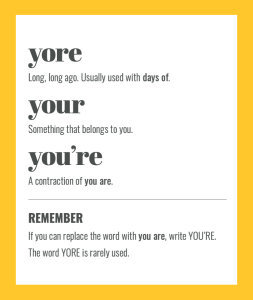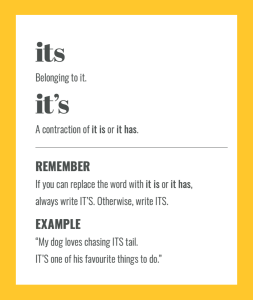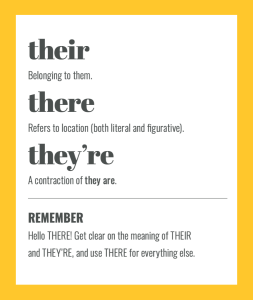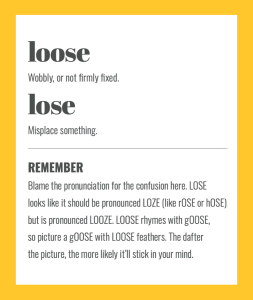You’re vs your: simple tips to get it right first time
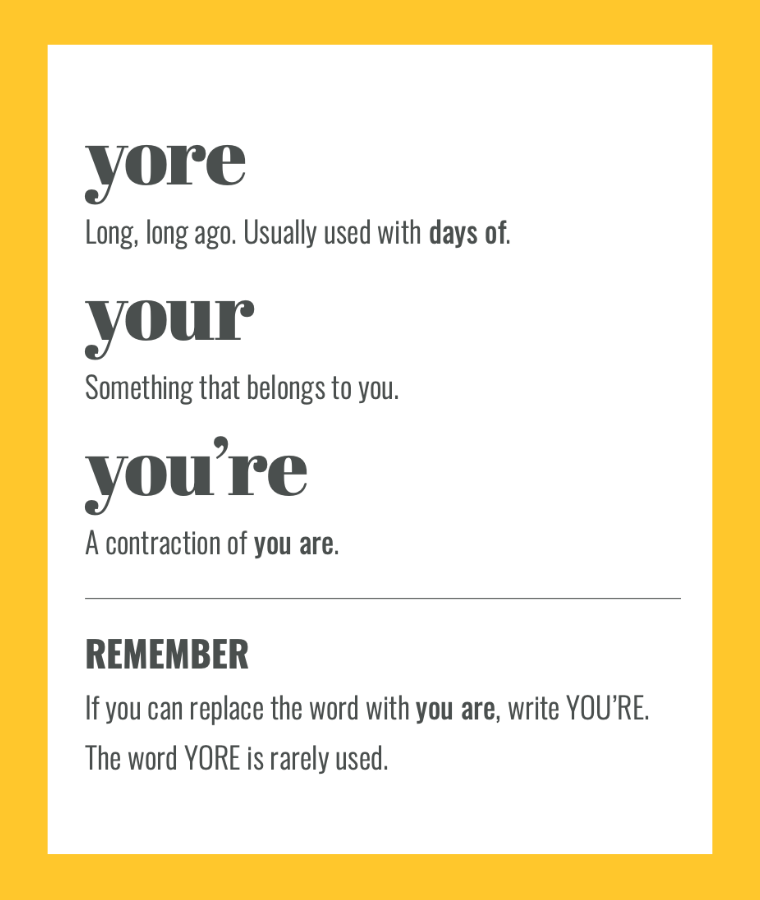
Do you know the difference between YOU’RE and YOUR? These simple tips will help you get it right every time.
In a nutshell, you’re is always a contraction of you are, while your describes something that belongs to you.
When to use YOU’RE
The apostrophe reminds you that you’re is a shortened form of you are. If you can replace the word with you are, use you’re.
When to use YOUR
Usually followed by a noun, describing something that belongs to you: your book, your dog, your job.
We get confused because we know apostrophes are used to indicate possession – that something belongs to someone: Amy’s dog, George’s car. But this doesn’t apply with pronouns – yours, his, hers, its, ours, theirs.
Example:
You’re going to get it right if you remember this – just use your head.
ADVANCED – if you’re already confused, save this for another day.
You’re and you’ll can sound similar in speech, and occasionally get mixed up.
Remember that you’ll means you WILL. Don’t write you’re (you ARE) when you mean you will.
Example:
You’ll be late – *applause*
You’re be late – quack quack oops
Get more tips in The Little Book of Confusables
Nine 10-second proofreading tips for mistake-free social media posts
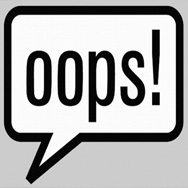
Social media has blurred the lines between formal and informal communication – but that doesn’t mean you can forget about spelling and grammar in your LinkedIn posts and tweets!
Here are nine ten-second proofreading tips to help you avoid spelling slip-ups and embarrassing errors.
1) Spellcheck
While I can’t stress enough that you should never rely on spellcheck alone, it’ll pick up obvious mistakes such as embarassed, neccessary and accomodate, as well as switched letter spellings (anyone else’s fingers do this?!) such as perosnal, diffciult, and whihc.
2) Read aloud
Proofreading on screen is fraught with danger. It’s far easier to spot mistakes and repetition – and to ensure consistency – when you check a printout. But printing a tweet? That’s not happening, is it?!
Get your computer to read your text aloud.
Copy and paste your post into Word, select the Review menu and click Read Aloud – or dig into your computer’s accessibility settings.
Listening to an automated voice read your words aloud is a great way to spot repetition, clunky phrasing and spelling mistakes.
3) Know your homophones
No, I’m not being rude.
We all have language blindspots when it comes to soundalike words such as affect and effect, principle and principal, compliment and complement.
Heaven forbid you ask your reader to ‘bare with me’.
Yikes!
The Little Book of Confusables contains fun, memorable spelling and usage tips for almost 600 commonly confused words, and will have you laughing while you’re learning.
4) Look for missing words
When you’re checking something you’ve written yourself, your brain will, rather unhelpfully, show you what you think you’ve written, rather than what you’ve actually written.
This even works when didn’t write the copy yourself.
(Did you automatically read the missing word?)
5) Beware one-i blindness
A common mistake is to drop the second i in words such as communities, utilities, facilities and difficulties.
Does your hotel really offer ‘great conference facilites’?
And are you sure you sell ‘affordable home insurance polices’?
6) Don’t write YOU when you mean YOUR
How often have you seen mistakes like this?
- Please complete you details below
- Does you website get you noticed?
- Convince you customers
Easy to miss, easy to rectify.
7) Check your #confusables
Just one letter difference between two words can create a whole new meaning.
Bought and brought, though and through, manager and manger, assess and asses, public and…
You get the picture.
The Little Book of Confusables has your back.
8) Ditch filler words
Make sure every word is working hard to get your message across.
Start by ditching unnecessary filler words, such as just, that, really and very.
❌ “I just thought that I’d share some really great tips…”
✅ “I thought I’d share some great tips”
Or, even better:
✅ “Here are some great tips”
9) Properly punctuate
Know your punctuation, and use it well.
Did you know, for example, that an ellipsis (one of these…) is always three dots – no more, no less?
Are you confident with the rules for using apostrophes?
Done properly, punctuation helps your reader understand your message. And that’s what it’s all about, right?!
Of course, these tips are great when you have time in your day to proofread your own work. When you don’t? Hire a professional.
It’s or its? Simple steps to help you remember
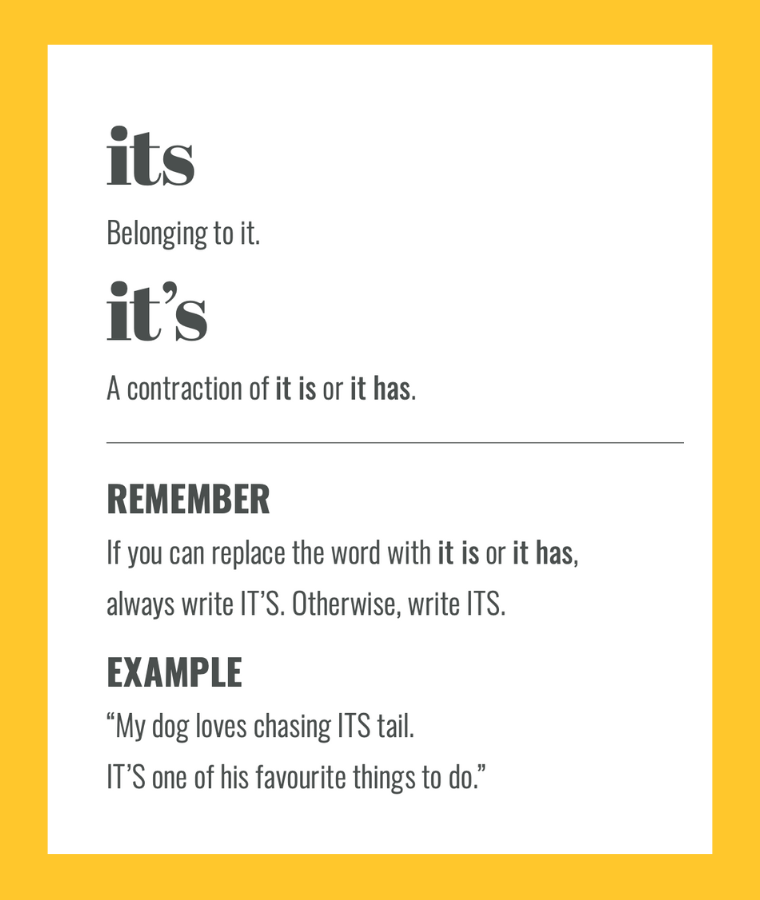
IT’S or ITS? These straightforward tips will help you remember the difference between these two commonly confused words.
Knowing whether to write it’s or its can trip you up.
In a nutshell, it’s is always a contraction of it is or it has, while its describes something that belongs to ‘it’.
It’s
The apostrophe reminds you that it’s is a contraction of it is or it has. If you can replace the word with ‘it is’ or ‘it has’ use it’s.
Example:
It’s easy when you remember this rule (it is).
It’s been a busy day (it has).
Its
Usually followed by a noun, its describes something that belongs to ‘it’:
Example:
The dog chased its tail.
We get confused because we know apostrophes are used to indicate possession – that something belongs to someone or something. But this rule doesn’t apply to pronouns – its, yours, his, hers, ours, theirs.
Get more tips in The Little Book of Confusables
There vs their vs they’re: top tips to help you get it right
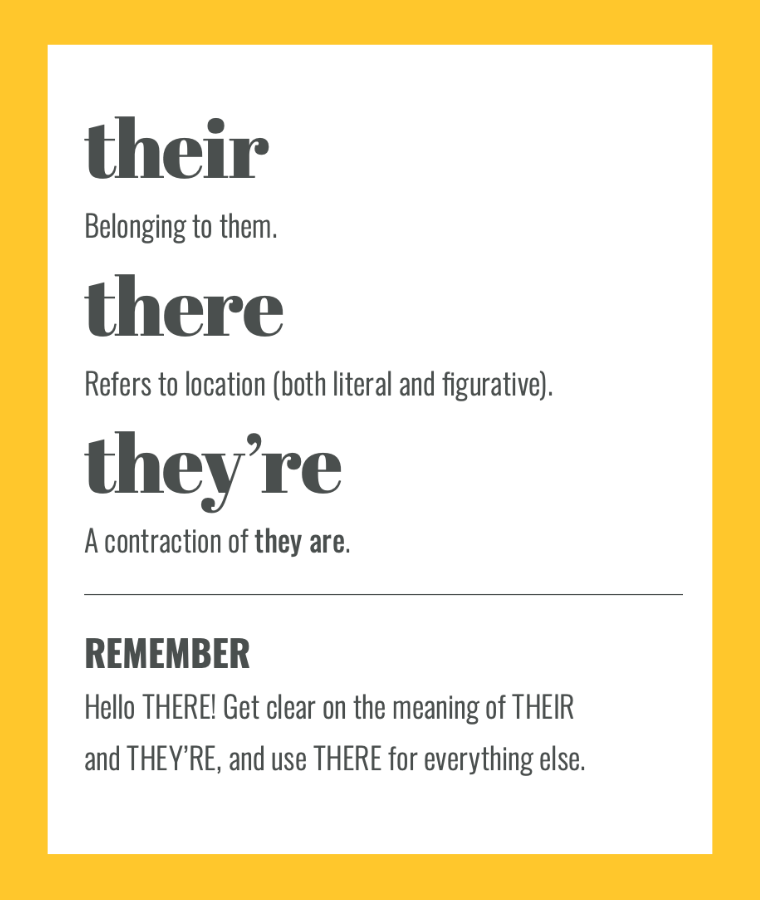
Using the wrong there/their/they’re is a common mistake – here are some simple tips to make sure you get it right.
In a nutshell, if the word means ‘belonging to them’ use their. If you can replace the word with ‘they are’ use they’re. Otherwise, use there.
There
It’s ‘here’ with a T: think here and there.
Example:
Did I leave my phone here? No, it’s over there.
Their
Used to indicate that a noun (thing) belongs to them.
Example:
That’s their house.
They’re
The apostrophe reminds you that ‘they’re’ is a contraction of two words: they are. Think of they’re as they are and you’ll know if your sentence makes sense.
Examples:
Look at the statue over they are: no – should be there
The boys are taking they are cars: no – should be their
They are here already: yes – they’re here already
ADVANCED – if you’re already confused, you might want to skip this.
Remember, there’s means there IS. Don’t write there’s when you mean there ARE.
Example:
There’s lots to do here – *applause*
There’s lots of cars in the car park – quack quack oops
Get more tips in The Little Book of Confusables
Don’t lose the plot: tips to remember lose and loose
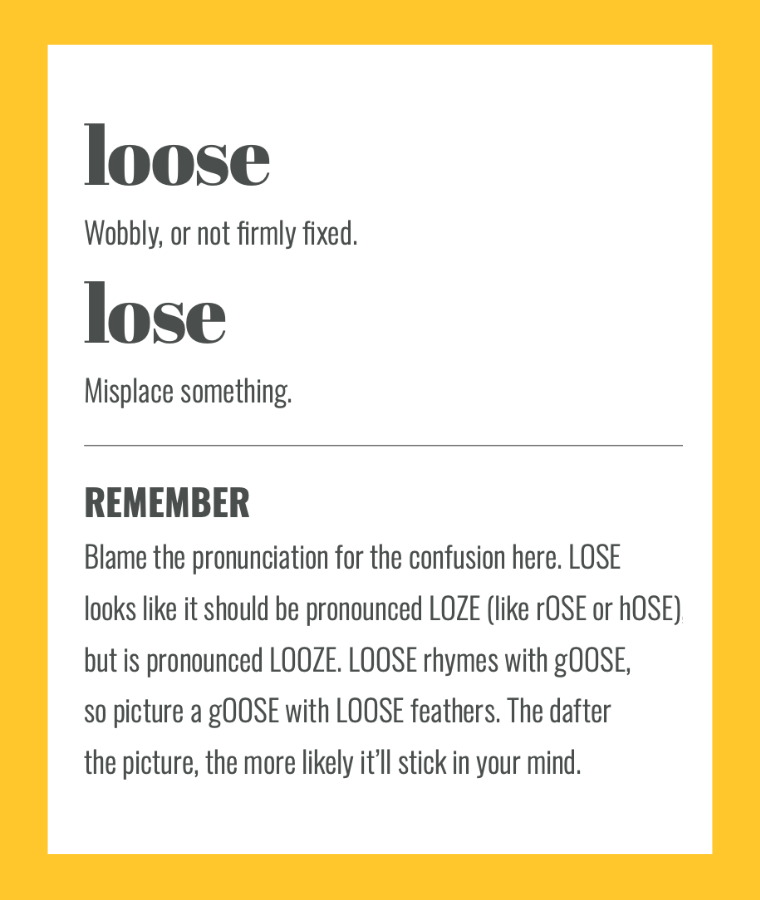
Do you know the difference between LOSE and LOOSE? Don’t learn the hard way, like Jessie J.
Last year, pop singer Jessie J admitted she’d had a tattoo of one of her song lyrics. Nothing unusual about that, maybe. But instead of ‘Don’t lose who you are in the blur of the stars’, the tattoo says ‘Don’t loose who you are in the blur of the stars’.
Imagine being tattooed with a typo. Double ouch.
It’s common for lose and loose to be mixed up, and easy to see why. But how do we avoid it?
Loose rhymes with moose and goose, but lose… well, it doesn’t rhyme with anything with the same ending.
Pose, nose and rose all end the same, but are all pronounced with an ‘oze’ sound. Only lose has an ‘oos’ sound.
What’s more, loose has the same ‘oose’ ending as choose, which rhymes with lose – gah!
When we think lose but write loose perhaps we’re thinking of loos which sounds the same, and contains a double o. But if that’s the case, we need to stop.
These tips should help you remember how to get it right:
- To write lose think of losing the second o. Or think of loser.
- Loose rhymes with moose, so picture a moose with loose antlers.
And Jessie – use a dictionary next time. Mamma Knows Best, remember?


